Investigation on Thermal Environment of Urban Slow Lane Based on Mobile Measurement Method—A Case Study of Swan Lake Area in Hefei, China
Abstract
1. Introduction
2. Materials and Methods
2.1. Study Area
2.2. Research Methods
2.2.1. Mobile Measurement Program
2.2.2. Introduction of the Classical Temporal Correction Model
2.2.3. Local Heat Island Intensity
2.2.4. ArcGIS Spatial Interpolation Method
3. Research Results
3.1. Comparison of Error Results of Four Temporal Correction Models
3.2. Distribution of Heat Island Intensity Along the Movement Route
3.3. Impact of Shading on UHI on Mobile Route
3.4. Analysis of the Factors Influencing the Hot Loop of a Slow-Moving Road
3.4.1. Permeable Underlying Surface (PSF)
3.4.2. Building Density (BD)
3.4.3. Shading Ratio (SR)
3.4.4. Sky View Factor (SVF)
3.4.5. Multivariate Fitting Analysis
4. Discussion
4.1. Comprehensive Analysis of Different Underlying Surface Parameters Affecting Slow Lane Thermal Environment
4.2. Urban Thermal Environment Optimization Recommendations
4.3. Limitations of the Study
5. Conclusions
Author Contributions
Funding
Institutional Review Board Statement
Informed Consent Statement
Data Availability Statement
Conflicts of Interest
References
- Xie, Q.; Sun, Q. Monitoring thermal environment deterioration and its dynamic response to urban expansion in Wuhan, China. Urban Clim. 2021, 39, 100932. [Google Scholar] [CrossRef]
- Wang, M.; Lu, H.; Chen, B.; Sun, W.; Yang, G. Fine-Scale Analysis of the Long-Term Urban Thermal Environment in Shanghai Using Google Earth Engine. Remote Sens. 2023, 15, 3732. [Google Scholar] [CrossRef]
- Kim, S.W.; Brown, R.D. Urban heat island (UHI) intensity and magnitude estimations: A systematic literature review. Sci. Total Environ. 2021, 779, 146389. [Google Scholar] [CrossRef]
- Ding, N.; Zhang, Y.; Wang, Y.; Chen, L.; Qin, K.; Yang, X. Effect of landscape pattern of urban surface evapotranspiration on land surface temperature. Urban Clim. 2023, 49, 101540. [Google Scholar] [CrossRef]
- Guzman, L.A.; Arellana, J.; Castro, W.F. Desirable streets for pedestrians: Using a street-level index to assess walkability. Transp. Res. Part D 2022, 111, 103462. [Google Scholar] [CrossRef]
- Hong, S.; Luo, Y.; Zhu, Y.; Huang, C.; Li, Y.; Sun, C. Childhood respiratory diseases related to indoor and outdoor extreme thermal environment (air temperature) in Shanghai, China. Indoor Built Environ. 2024, 33, 341–358. [Google Scholar] [CrossRef]
- Cao, X.; Tang, B.; Zou, X.; He, L. Analysis on the cooling effect of a heat-reflective coating for asphalt pavement. Road Mater. Pavement Des. 2015, 16, 716–726. [Google Scholar] [CrossRef]
- Cleland, S.E.; Steinhardt, W.; Neas, L.M.; West, J.J.; Rappold, A.G. Urban heat island impacts on heat-related cardiovascular morbidity: A time series analysis of older adults in US metropolitan areas. Environ. Int. 2023, 178, 108005. [Google Scholar] [CrossRef]
- Lee, M.; Kim, S.; Kim, H.; Hwang, S. Pedestrian visual satisfaction and dissatisfaction toward physical components of the walking environment based on types, characteristics, and combinations. Build. Environ. 2023, 244, 110776. [Google Scholar] [CrossRef]
- Zhang, X.; Kasimu, A.; Liang, H.; Wei, B.; Aizizi, Y.; Zhao, Y.; Reheman, R. Construction of Urban Thermal Environment Network Based on Land Surface Temperature Downscaling and Local Climate Zones. Remote Sens. 2023, 15, 1129. [Google Scholar] [CrossRef]
- Atri, M.; Nedae-Tousi, S.; Shahab, S.; Solgi, E. The Effects of Thermal-Spatial Behaviours of Land Covers on Urban Heat Islands in Semi-Arid Climates. Sustainability 2021, 13, 13824. [Google Scholar] [CrossRef]
- Lu, Y.; Yue, W.; Liu, Y.; Huang, Y. Investigating the spatiotemporal non-stationary relationships between urban spatial form and land surface temperature: A case study of Wuhan, China. Sustain. Cities Soc. 2021, 72, 103070. [Google Scholar] [CrossRef]
- Zhou, X.; Chen, H. Experimental Analysis of the Influence of Urban Morphological Indices on the Urban Thermal Environment of Zhengzhou, China. Atmosphere 2021, 12, 1058. [Google Scholar] [CrossRef]
- Ibrahim, A.; Ali, H.; Abuhendi, F.; Jaradat, S. Thermal seasonal variation and occupants’ spatial behaviour in domestic spaces. Build. Res. Inf. 2019, 48, 364–378. [Google Scholar] [CrossRef]
- Yang, J.; Nam, I.; Sohn, J.-R. The influence of seasonal characteristics in elderly thermal comfort in Korea. Energy Build. 2016, 128, 583–591. [Google Scholar] [CrossRef]
- Yin, P.; Xie, J.; Ji, Y.; Liu, J.; Hou, Q.; Zhao, S.; Jing, P. Winter indoor thermal environment and heating demand of low-quality centrally heated houses in cold climates. Appl. Energy 2023, 331, 120480. [Google Scholar] [CrossRef]
- Mallick, J. Evaluation of Seasonal Characteristics of Land Surface Temperature with NDVI and Population Density. Pol. J. Environ. Stud. 2021, 30, 3163–3180. [Google Scholar] [CrossRef]
- Fang, Z.; Zhang, F.; Guo, Z.; Zheng, Z.; Feng, X. Investigation into the outdoor thermal comfort on different urban underlying surfaces. Urban Clim. 2024, 55, 101911. [Google Scholar] [CrossRef]
- Cheela, V.R.S.; John, M.; Biswas, W.; Sarker, P. Combating Urban Heat Island Effect—A Review of Reflective Pavements and Tree Shading Strategies. Buildings 2021, 11, 93. [Google Scholar] [CrossRef]
- Zou, Z.; Yan, C.; Yu, L.; Jiang, X.; Ding, J.; Qin, L.; Wang, B.; Qiu, G. Impacts of land use/ land cover types on interactions between urban heat island effects and heat waves. Build. Environ. 2021, 204, 108138. [Google Scholar] [CrossRef]
- Rahman, M.A.; Dervishi, V.; Moser-Reischl, A.; Ludwig, F.; Pretzsch, H.; Rötzer, T.; Pauleit, S. Comparative analysis of shade and underlying surfaces on cooling effect. Urban For. Urban Green. 2021, 63, 127223. [Google Scholar] [CrossRef]
- Shu, B.; Chang, H.T.; Chen, Y.X. Influence of the thermal environment of urban sidewalks under green shading from a human scale. All Earth 2024, 36, 127223. [Google Scholar] [CrossRef]
- Kong, H.; Choi, N.; Park, S. Thermal environment analysis of landscape parameters of an urban park in summer—A case study in Suwon, Republic of Korea. Urban For. Urban Green. 2021, 65, 127377. [Google Scholar] [CrossRef]
- Meili, N.; Acero, J.A.; Peleg, N.; Manoli, G.; Burlando, P.; Fatichi, S. Vegetation cover and plant-trait effects on outdoor thermal comfort in a tropical city. Build. Environ. 2021, 58, 107733. [Google Scholar] [CrossRef]
- Meili, N.; Manoli, G.; Burlando, P.; Carmeliet, J.; Chow, W.T.; Coutts, A.M.; Roth, M.; Velasco, E.; Vivoni, E.R.; Fatichi, S. Tree effects on urban microclimate: Diurnal, seasonal, and climatic temperature differences explained by separating radiation, evapotranspiration, and roughness effects. Urban For. Urban Green. 2020, 58, 126970. [Google Scholar] [CrossRef]
- Manley, G. On the frequency of snowfall in metropolitan England. Q. J. R. Meteorol. Soc. 1958, 84, 70–72. [Google Scholar] [CrossRef]
- Basu, R.; Ostro, B.D. A multicounty analysis identifying the populations vulnerable to mortality associated with high ambient temperature in California. Am. J. Epidemiol. 2008, 168, 632–637. [Google Scholar] [CrossRef]
- Manoli, G.; Fatichi, S.; Schläpfer, M.; Yu, K.; Crowther, T.W.; Meili, N.; Burlando, P.; Katul, G.G.; Bou-Zeid, E. Magnitude of urban heat islands largely explained by climate and population. Nature 2019, 573, 55. [Google Scholar] [CrossRef]
- Mohite, S.; Surawar, M. Impact of urban street geometry on outdoor pedestrian thermal comfort during heatwave in Nagpur city. Sustain. Cities Soc. 2024, 108, 105450. [Google Scholar] [CrossRef]
- Pan, Y.; Li, S.; Tang, X. Investigation of Bus Shelters and Their Thermal Environment in Hot–Humid Areas—A Case Study in Guangzhou. Buildings 2024, 14, 2377. [Google Scholar] [CrossRef]
- Kim, E.J.; Kim, H. Walking-based mobile measurement: Examining its reliability for spatial thermal characteristics in urban environments. Urban Clim. 2024, 58, 102154. [Google Scholar] [CrossRef]
- Jiang, L.; Zhao, H.; Cao, B.; He, W.; Yun, Z.; Cheng, C. A UAV Thermal Imaging Format Conversion System and Its Application in Mosaic Surface Microthermal Environment Analysis. Sensors 2024, 24, 6267. [Google Scholar] [CrossRef] [PubMed]
- Parison, S.; Hendel, M.; Royon, L. A statistical method for quantifying the field effects of urban heat island mitigation techniques. Urban Clim. 2020, 33, 100651. [Google Scholar] [CrossRef]
- Parison, S.; Chaumont, M.; Kounkou-Arnaud, R.; Long, F.; Bernik, A.; Da Silva, M.; Hendel, M. The effects of greening a parking lot as a heat mitigation strategy on outdoor thermal stress using fixed and mobile measurements: Case-study project “tertiary forest”. Sustain. Cities Soc. 2023, 98, 104818. [Google Scholar] [CrossRef]
- Ye, X.; Ren, H.; Wang, P.; Duan, Y.; Zhu, J. Urban LST Retrieval From the Ultrahigh Spatial Resolution Remote Sensing Data. IEEE Geosci. Remote Sens. Lett. 2024, 21, 7000305. [Google Scholar] [CrossRef]
- Costanzini, S.; Despini, F.; Beltrami, L.; Fabbi, S.; Muscio, A.; Teggi, S. Identification of SUHI in Urban Areas by Remote Sensing Data and Mitigation Hypothesis through Solar Reflective Materials. Atmosphere 2022, 13, 70. [Google Scholar] [CrossRef]
- Luo, T.; He, Q.; Wang, W.; Fan, X. Response of summer Land surface temperature of small and medium-sized cities to their neighboring urban spatial morphology. Build. Environ. 2024, 250, 111198. [Google Scholar] [CrossRef]
- Schnell, I.; Cohen, P.; Mandelmilch, M.; Potchter, O. Portable-trackable methodologies for measuring personal and place exposure to nuisances in urban environments: Towards a people oriented paradigm. Comput. Environ. Urban Syst. 2021, 86, 101589. [Google Scholar] [CrossRef]
- Pigliautile, I.; D’eramo, S.; Pisello, A.L. Intra-urban microclimate mapping for citizens’ wellbeing: Novel wearable sensing techniques and automatized data-processing. J. Clean. Prod. 2021, 279, 123748. [Google Scholar] [CrossRef]
- Sundborg, A. Climatlogical studies in Uppsala with special regard to the temperature conditions in the urban area. Georaphica 1951, 22. [Google Scholar]
- Masashi, M.; Minako, N.; Masaki, N.; Masatoshi, N. Study on temperature distribution of an urbanized area using a vehicle with mobile measurement system. J. Environ. Eng. 2009, 74, 1179–1185. [Google Scholar]
- Leconte, F.; Bouyer, J.; Claverie, R.; Pétrissans, M. Using Local Climate Zone scheme for UHI assessment: Evaluation of the method using mobile measurements. Build. Environ. 2015, 83, 39–49. [Google Scholar] [CrossRef]
- Liu, L.; Liu, J.; Lin, Y. Spatial-temporal Analysis of the Urban Heat Island of a Subtropical City by Using Mobile Measurement. Procedia Eng. 2016, 169, 55–63. [Google Scholar] [CrossRef]
- Cao, C.; Yang, Y.; Lu, Y.; Schultze, N.; Gu, P.; Zhou, Q.; Xu, J.; Lee, X. Performance Evaluation of a Smart Mobile Air Temperature and Humidity Sensor for Characterizing Intracity Thermal Environment. J. Atmos. Ocean. Technol. 2020, 37, 1891–1905. [Google Scholar] [CrossRef]
- Emery, J.; Pohl, B.; Crétat, J.; Richard, Y.; Pergaud, J.; Rega, M.; Zito, S.; Dudek, J.; Vairet, T.; Joly, D.; et al. How local climate zones influence urban air temperature: Measurements by bicycle in Dijon, France. Urban Clim. 2021, 40, 101017. [Google Scholar] [CrossRef]
- Chàfer, M.; Tan, C.L.; Cureau, R.J.; Hien, W.N.; Pisello, A.L.; Cabeza, L.F. Mobile measurements of microclimatic variables through the central area of Singapore: An analysis from the pedestrian perspective. Sustain. Cities Soc. 2022, 83, 103986. [Google Scholar] [CrossRef]
- Shimazaki, Y.; Aoki, M.; Nitta, J.; Okajima, H.; Yoshida, A. Experimental Determination of Pedestrian Thermal Comfort on Water-Retaining Pavement for UHI Adaptation Strategy. Atmosphere 2021, 12, 127. [Google Scholar] [CrossRef]
- May, S.; Oliphant, A.J. Characteristics of the Park Cool Island in Golden Gate Park, San Francisco. Theor. Appl. Climatol. 2023, 151, 1269–1282. [Google Scholar] [CrossRef]
- Jin, L.; Pan, X.; Liu, L.; Liu, L.; Liu, J.; Gao, Y. Block-based local climate zone approach to urban climate maps using the UDC model. Build. Environ. 2020, 186, 107334. [Google Scholar] [CrossRef]
- Fung, W.Y.; Lam, K.S.; Nichol, J.; Wong, M.S. Derivation of Nighttime Urban Air Temperatures Using a Satellite Thermal Image. J. Appl. Meteorol. Climatol. 2009, 48, 863–872. [Google Scholar] [CrossRef]
- Zhou, Y.; Luo, Y.; Yi, X.; Lun, F.; Hu, Q.; Huang, N.; Wen, G.; Zhou, H.; Hu, X. Exploring the influence of local urban heat features on park cooling effects: Insights from Chinese cities. Build. Environ. 2024, 262, 111782. [Google Scholar] [CrossRef]
- Liu, L.; Lin, Y.; Wang, D.; Liu, J. Dynamic Spatial-temporal Evaluations of Urban Heat Islands and Thermal Comfort of a Complex Urban District Using an Urban Canopy Model. J. Asian Archit. Build. Eng. 2016, 15, 627–634. [Google Scholar] [CrossRef]
- Yu, Z.; Song, Y.; Song, D.; Liu, Y. Spatial interpolation-based analysis method targeting visualization of the indoor thermal environment. Build. Environ. 2020, 188, 107484. [Google Scholar] [CrossRef]
- Gong, Y.; Li, X.; Liu, H.; Li, Y. The Spatial Pattern and Mechanism of Thermal Environment in Urban Blocks from the Perspective of Green Space Fractal. Buildings 2023, 13, 574. [Google Scholar] [CrossRef]
- Chen, R.; You, X. Reduction of urban heat island and associated greenhouse gas emissions. Mitig. Adapt. Strateg. Glob. Chang. 2020, 25, 689–711. [Google Scholar] [CrossRef]
- Chen, X.; Wang, Z.; Bao, Y.; Luo, Q.; Wei, W. Combined impacts of buildings and urban remnant mountains on thermal environment in multi-mountainous city. Sustain. Cities Soc. 2022, 87, 104247. [Google Scholar] [CrossRef]
- Yang, J.; Shi, B.; Xia, G.; Xue, Q.; Cao, S.-J. Impacts of Urban Form on Thermal Environment Near the Surface Region at Pedestrian Height: A Case Study Based on High-Density Built-Up Areas of Nanjing City in China. Sustainability 2020, 87, 1737. [Google Scholar] [CrossRef]
- Wang, R.; Liu, R.; Chen, Q.; Cheng, Q.; Du, M. Effects of Sky View Factor on Thermal Environment in Different Local Climate Zoning Building Scenarios—A Case Study of Beijing, China. Buildings 2023, 13, 1882. [Google Scholar] [CrossRef]
- Zhu, Y.; Kensek, K.M. Mitigating the Urban Heat Island Effect: The Thermal Performance of Shade-Tree Planting in Downtown Los Angeles. Sustainability 2024, 16, 8768. [Google Scholar] [CrossRef]
- Elmarakby, E.; Khalifa, M.; Elshater, A.; Afifi, S. Tailored methods for mapping urban heat islands in Greater Cairo Region. Ain Shams Eng. J. 2022, 13, 101545. [Google Scholar] [CrossRef]
- Elshater, A.; Abusaada, H.; Alfiky, A.; El-Bardisy, N.; Elmarakby, E.; Grant, S. Workers’ Satisfaction vis-à-vis Environmental and Socio-Morphological Aspects for Sustainability and Decent Work. Sustainability 2022, 14, 1699. [Google Scholar] [CrossRef]
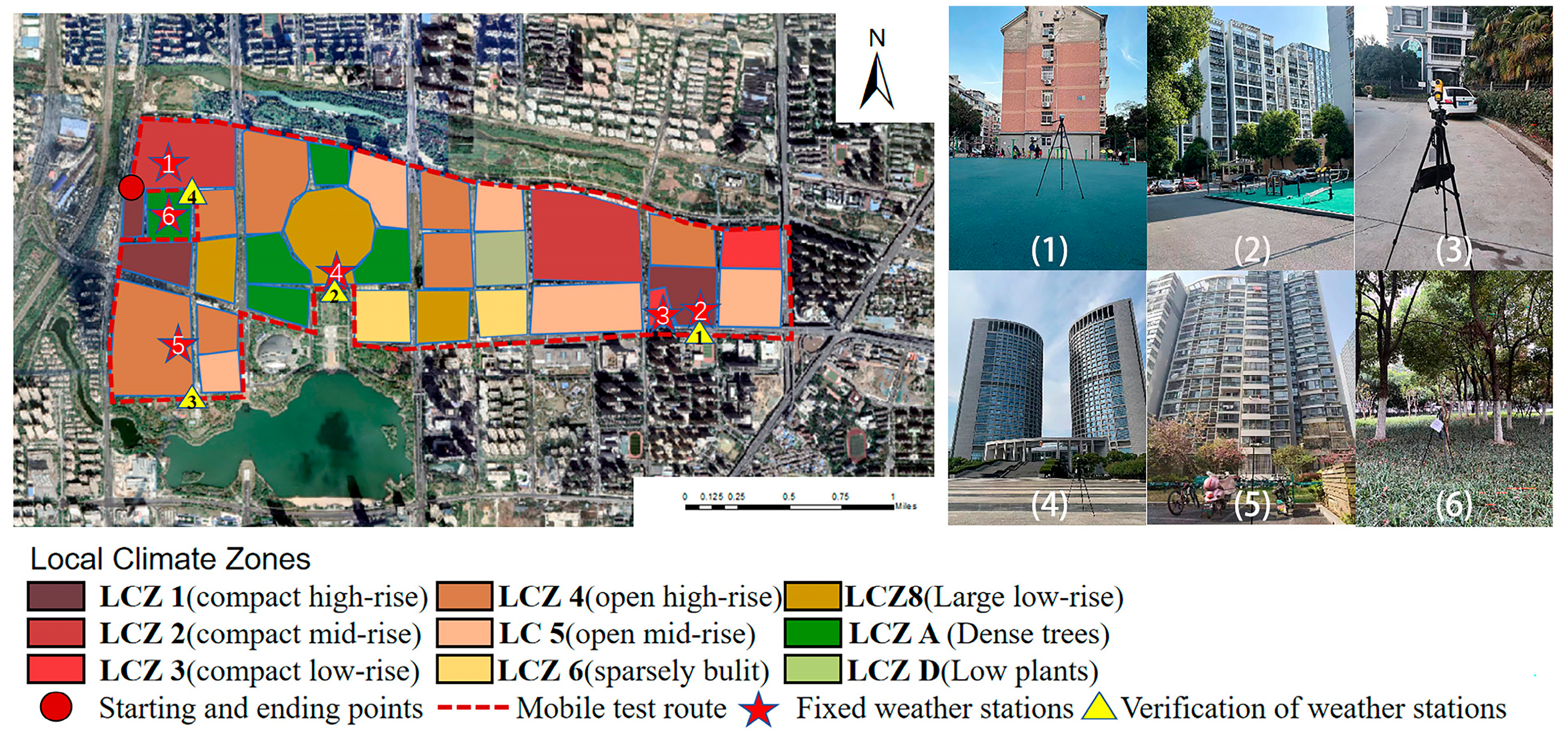
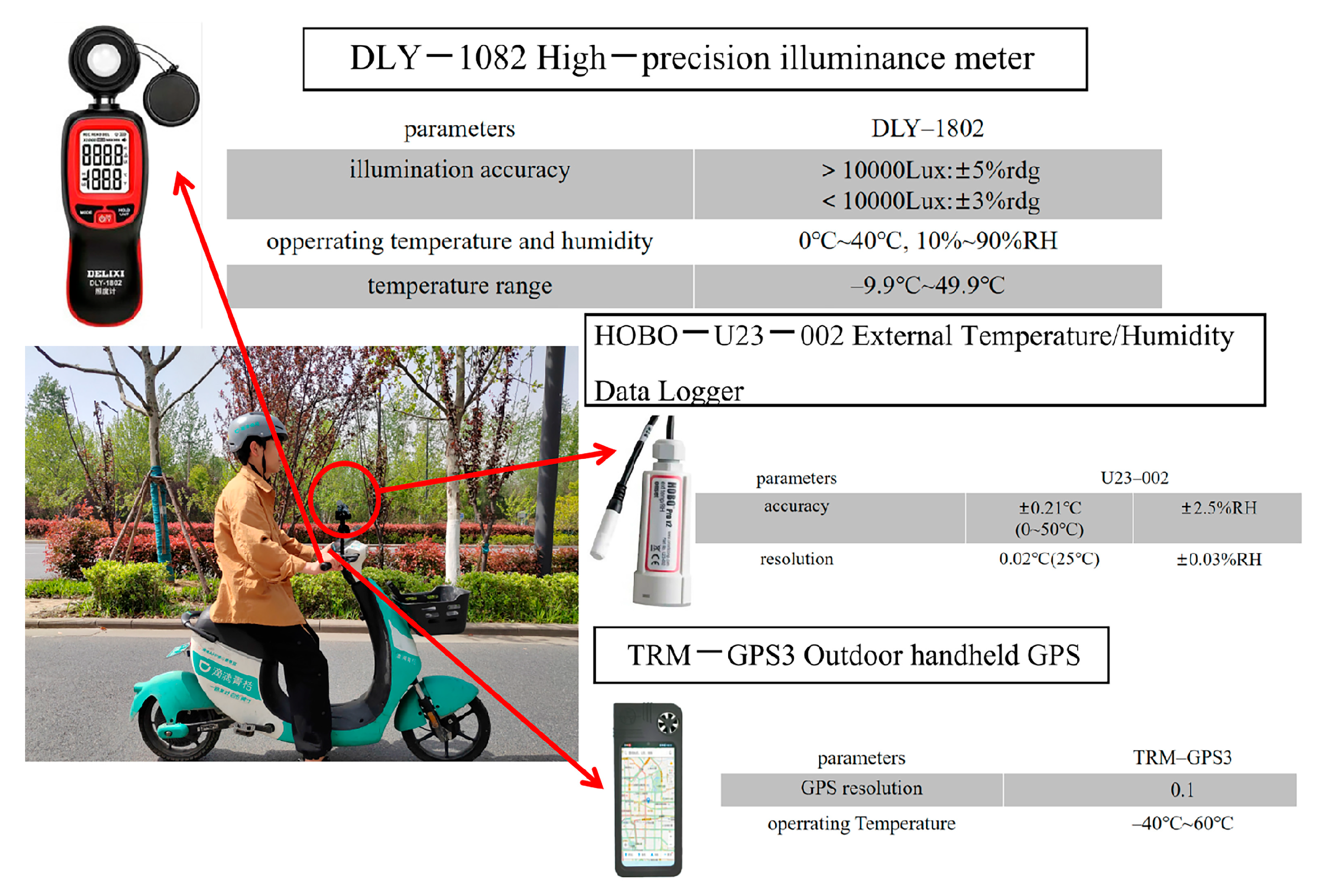
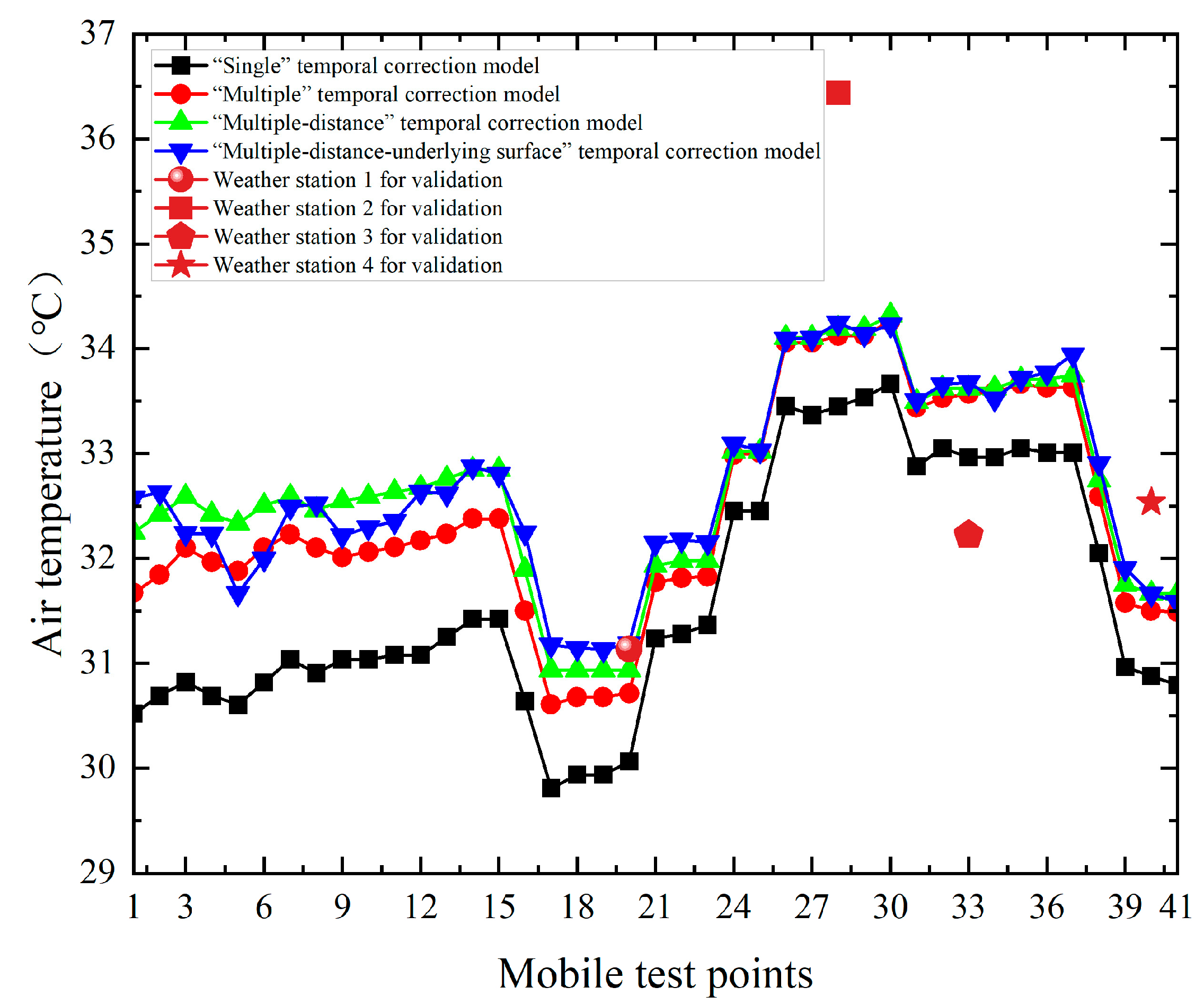

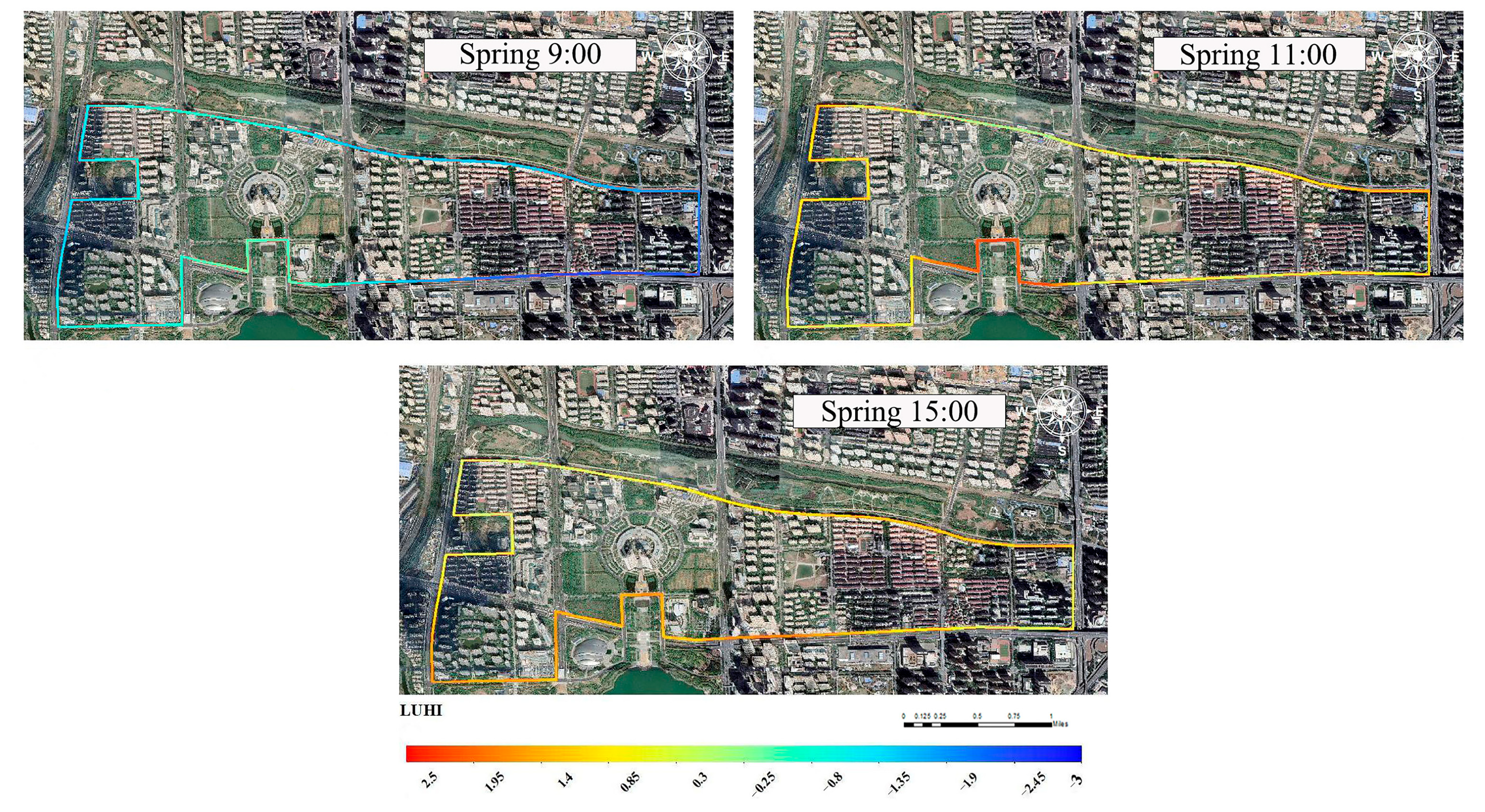
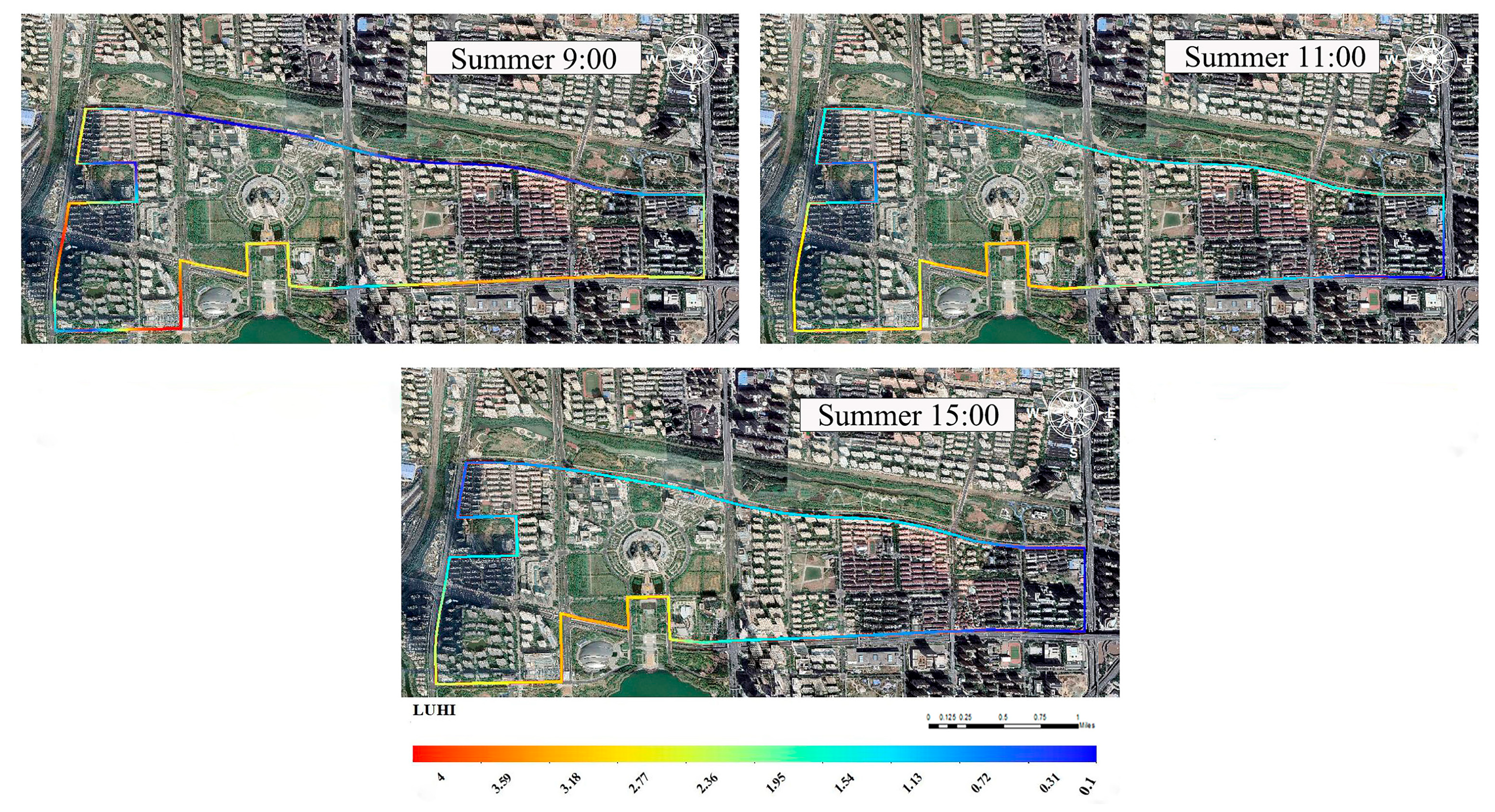

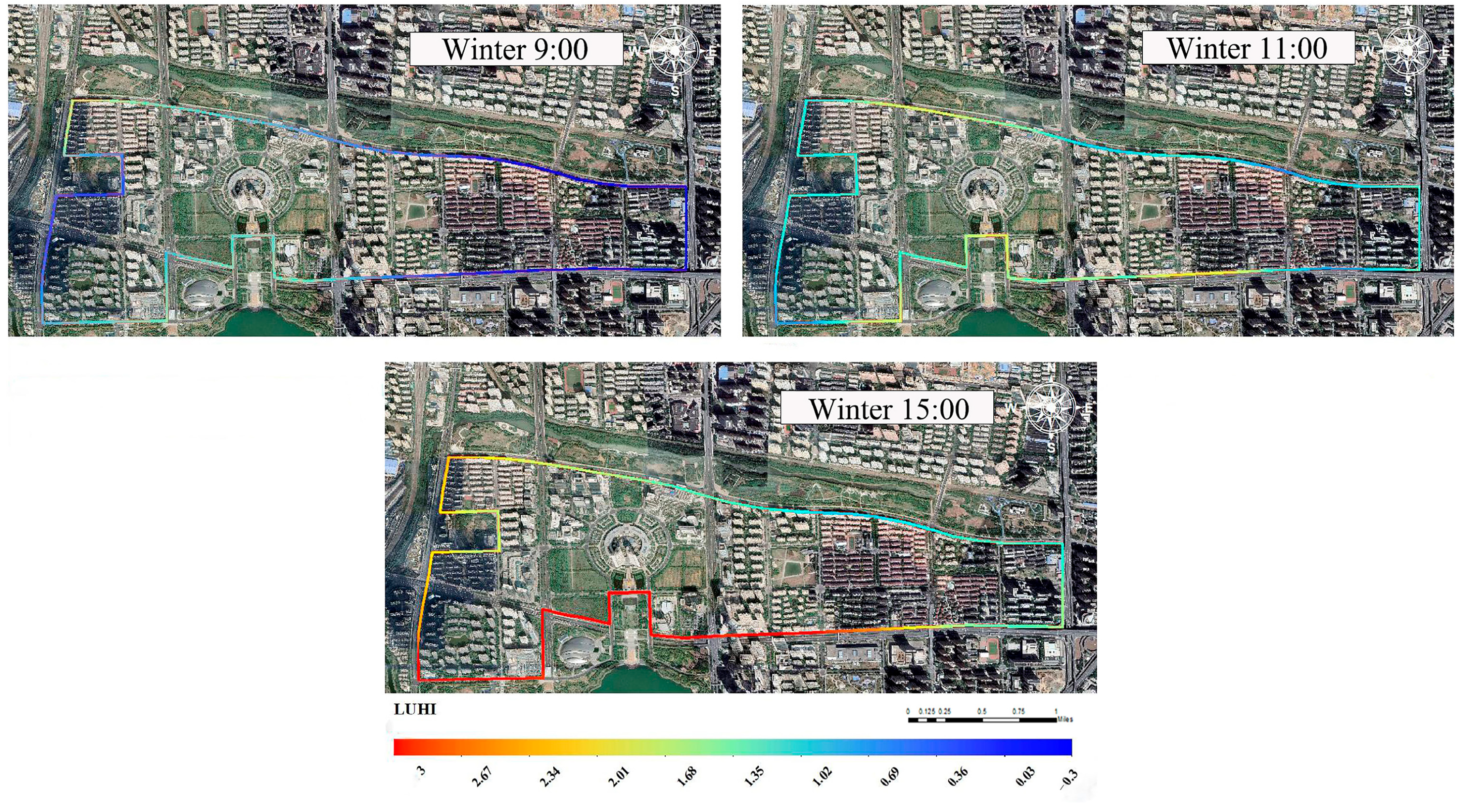
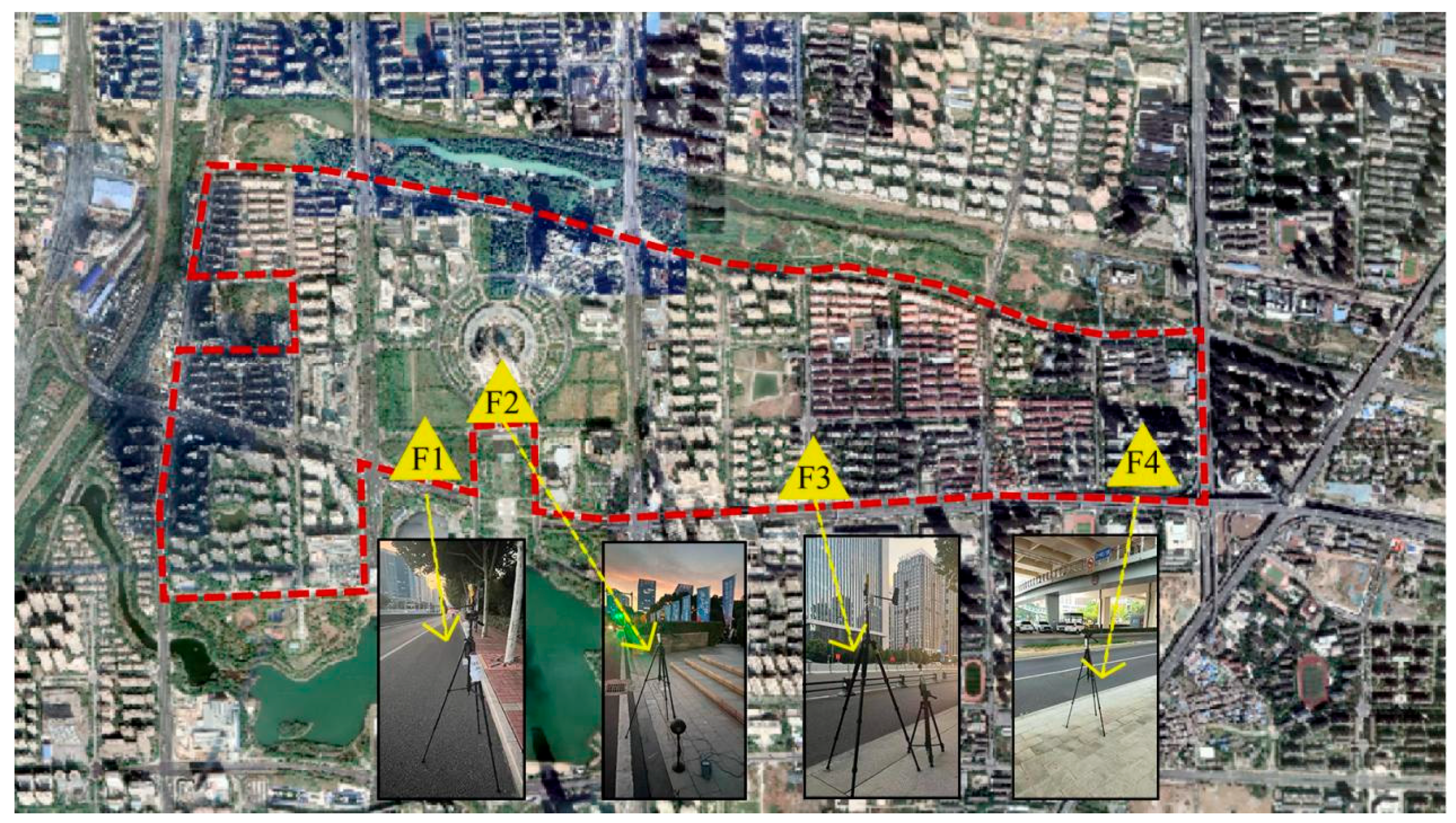
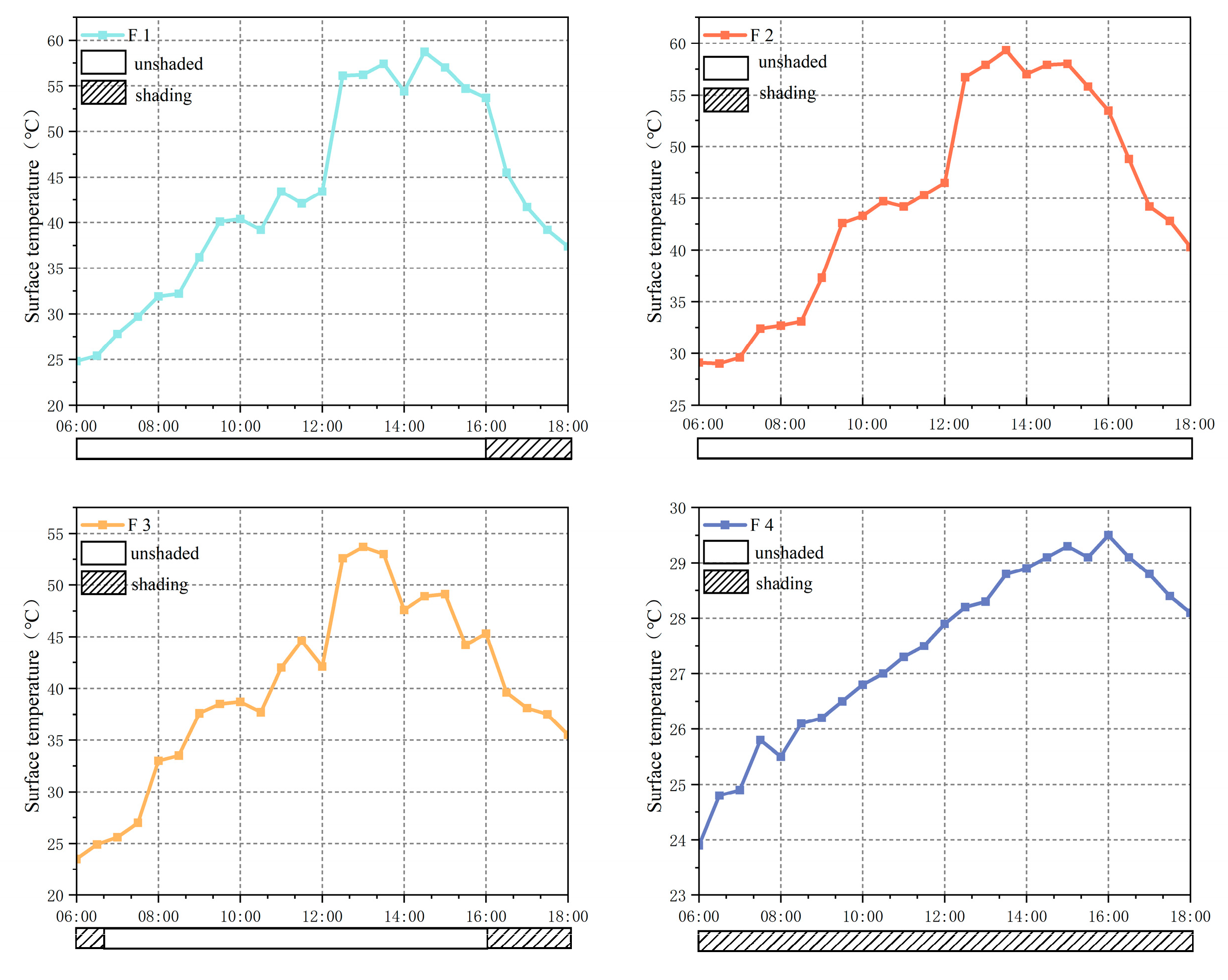
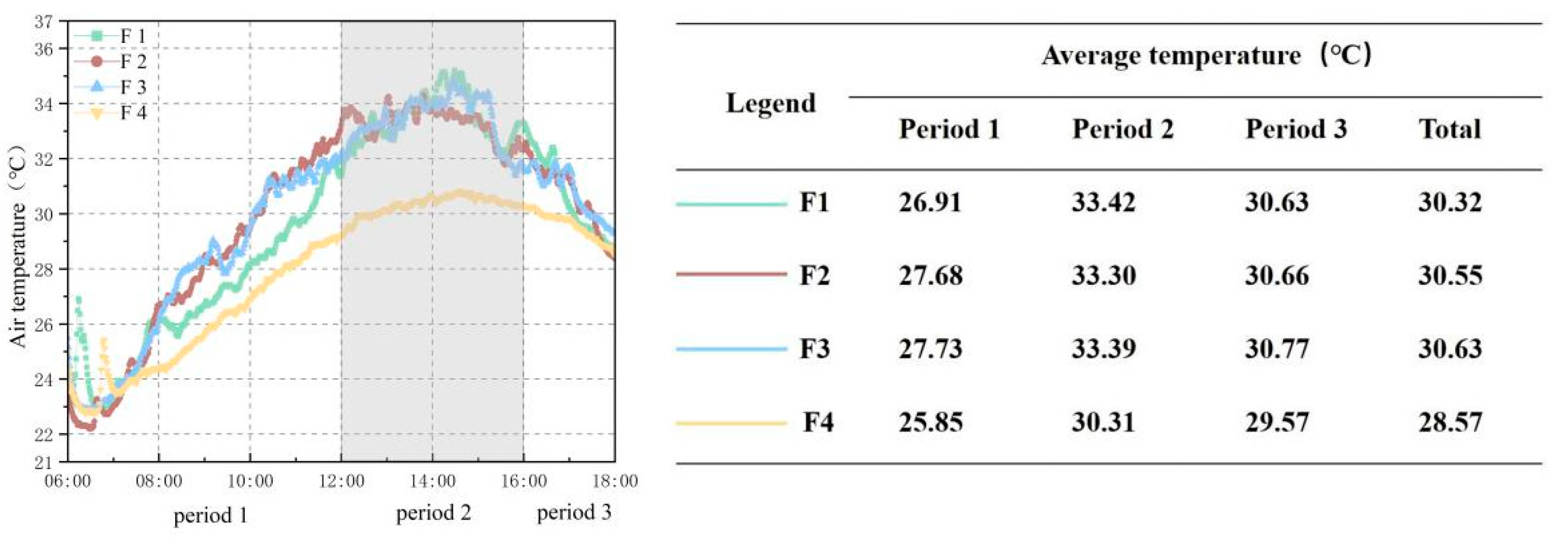
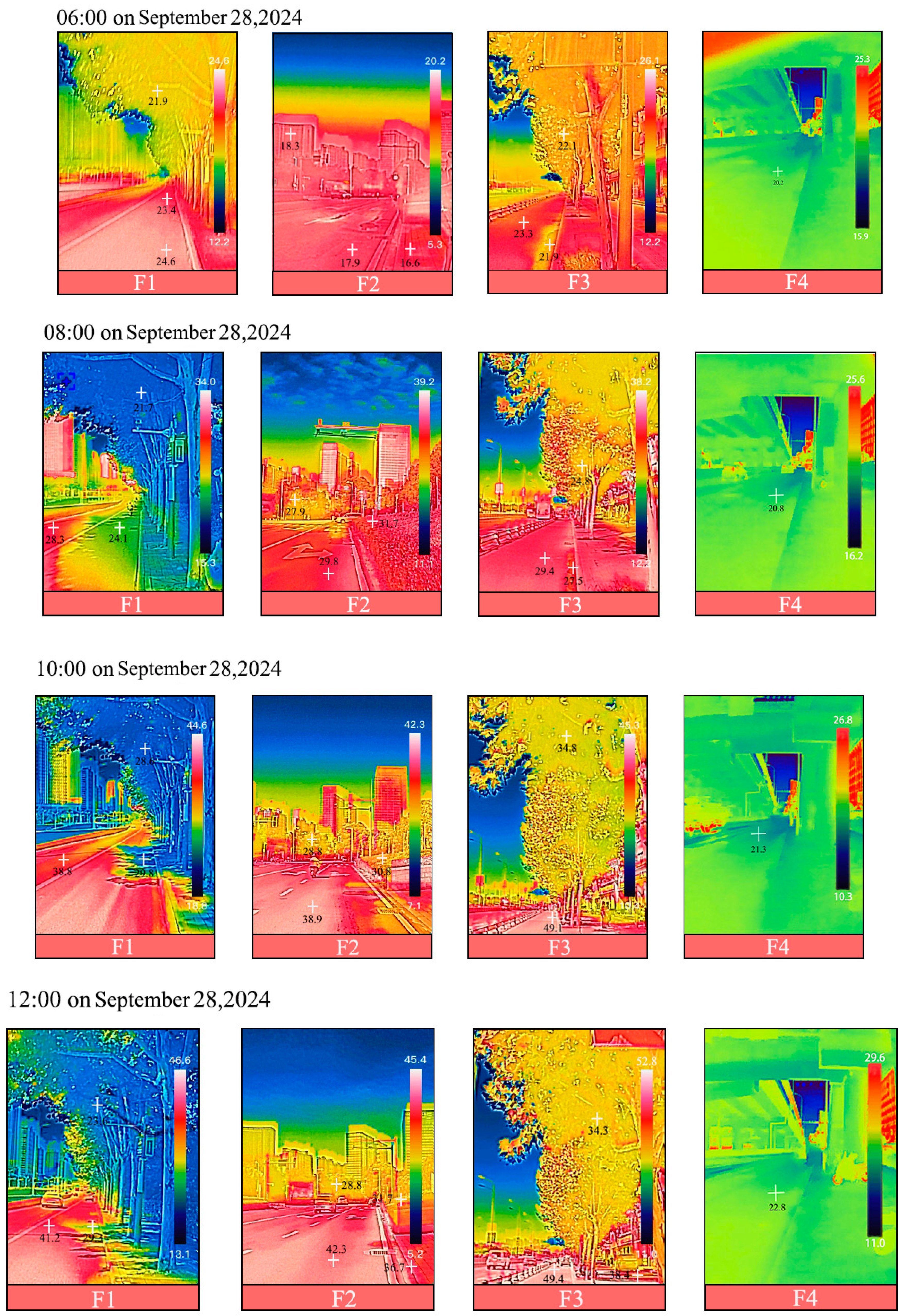


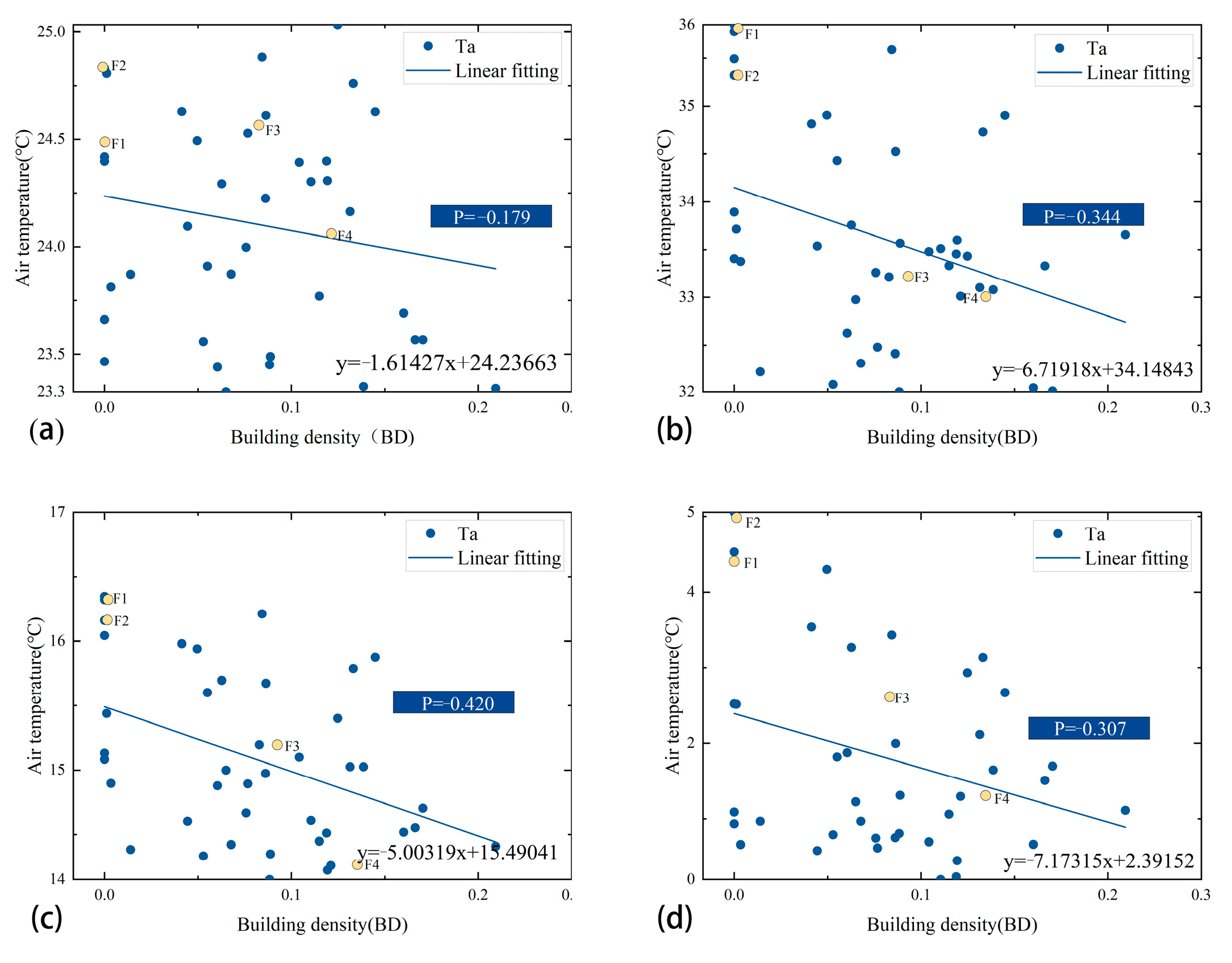
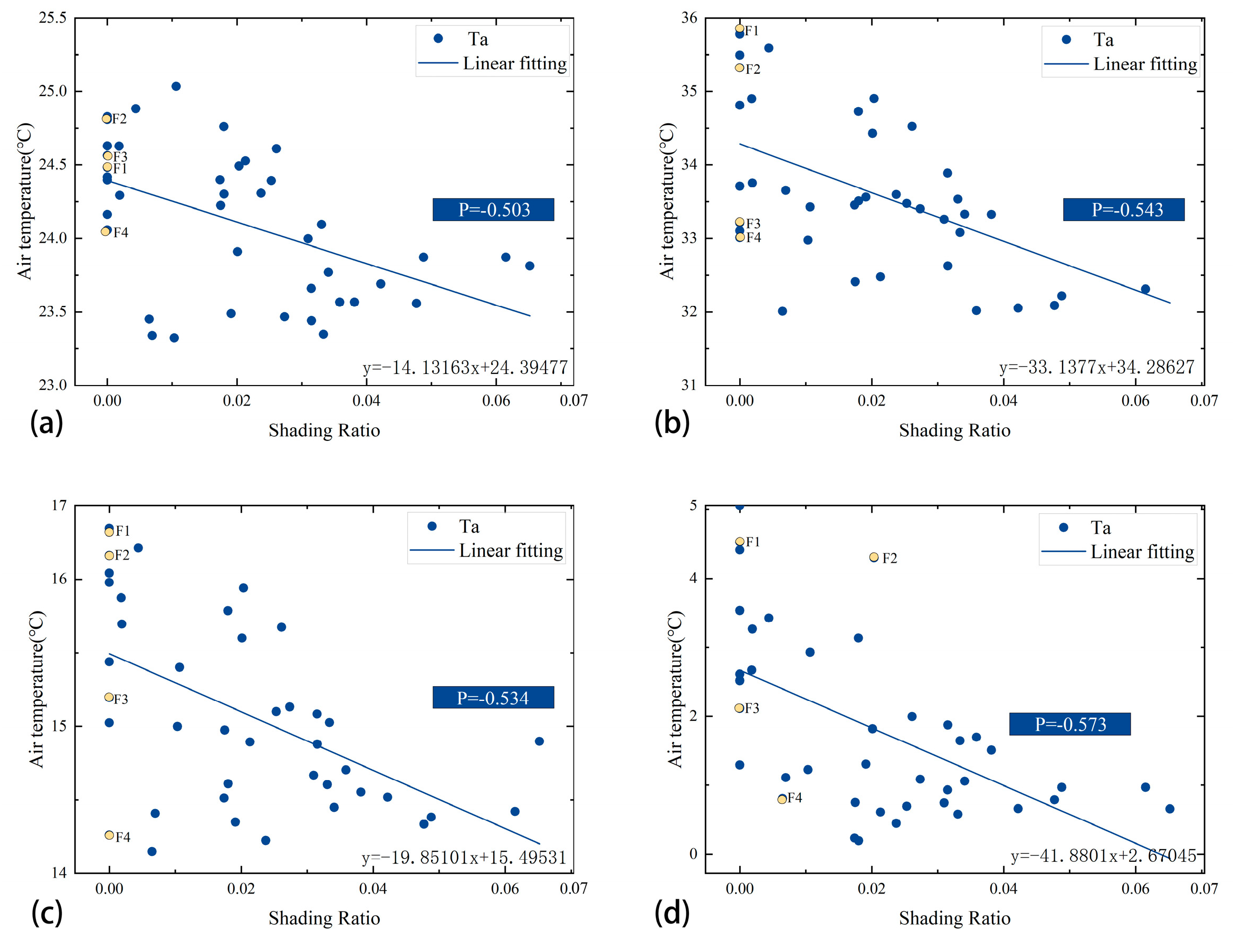
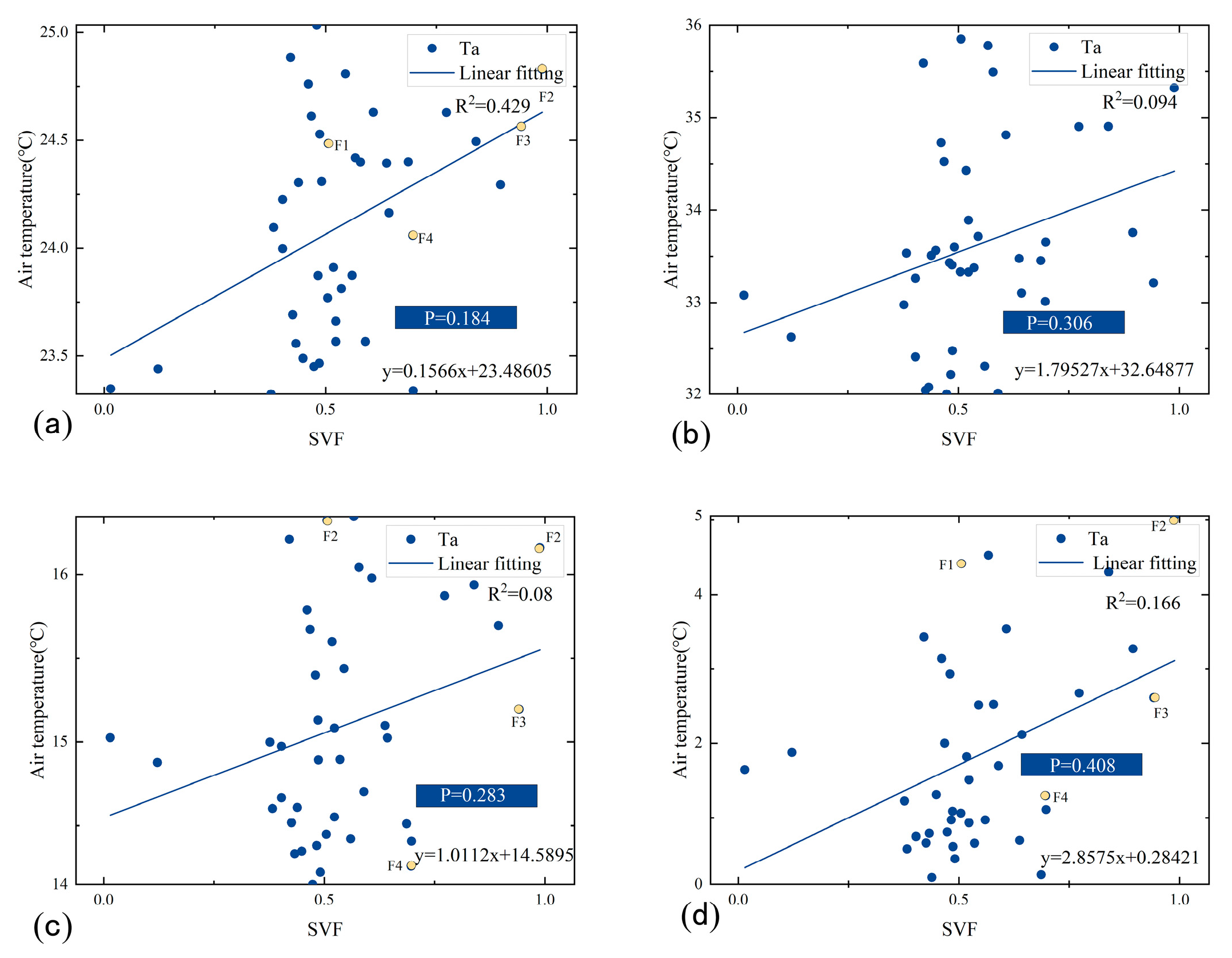
| Models | Station Number | Calculation Formula |
|---|---|---|
| “Single” temporal correction model [50] | N = 1 | |
| “Multiple” temporal correction model [41] | N > 1 | |
| “Multiple-distance” temporal correction model [32] | N > 1 | |
| “Multiple-distance-underlying surface” temporal correction model [43] | N > 1 |
| Models | Air Temperature | |
|---|---|---|
| MAE (°C) | RMSE (°C) | |
| “Single” temporal correction model | 1.615 | 1.829 |
| “Multiple” temporal correction model | 1.282 | 1.454 |
| “Multiple-distance” temporal correction model | 1.236 | 1.410 |
| “Multiple-distance-underlying surface” temporal correction model | 1.144 | 1.387 |
| Terms | Standardized Coefficients for Terms in Equation (4) | Standardized Coefficients for Terms in Equation (5) | Standardized Coefficients for Terms in Equation (6) | Standardized Coefficients for Terms in Equation (7) |
|---|---|---|---|---|
| PSF | 0.193 | 0.332 | 0.286 | 0.123 |
| BD | −0.138 | −0.297 | −0.379 | −0.272 |
| SR | −0.402 | −0.517 | −0.516 | −0.493 |
| SVF | 0.259 | 0.082 | 0.054 | 0.190 |
Disclaimer/Publisher’s Note: The statements, opinions and data contained in all publications are solely those of the individual author(s) and contributor(s) and not of MDPI and/or the editor(s). MDPI and/or the editor(s) disclaim responsibility for any injury to people or property resulting from any ideas, methods, instructions or products referred to in the content. |
© 2025 by the authors. Licensee MDPI, Basel, Switzerland. This article is an open access article distributed under the terms and conditions of the Creative Commons Attribution (CC BY) license (https://creativecommons.org/licenses/by/4.0/).
Share and Cite
Li, M.; Shui, T.; Shi, L.; Cao, R. Investigation on Thermal Environment of Urban Slow Lane Based on Mobile Measurement Method—A Case Study of Swan Lake Area in Hefei, China. Buildings 2025, 15, 388. https://doi.org/10.3390/buildings15030388
Li M, Shui T, Shi L, Cao R. Investigation on Thermal Environment of Urban Slow Lane Based on Mobile Measurement Method—A Case Study of Swan Lake Area in Hefei, China. Buildings. 2025; 15(3):388. https://doi.org/10.3390/buildings15030388
Chicago/Turabian StyleLi, Mengyuan, Taotao Shui, Linpo Shi, and Ruxue Cao. 2025. "Investigation on Thermal Environment of Urban Slow Lane Based on Mobile Measurement Method—A Case Study of Swan Lake Area in Hefei, China" Buildings 15, no. 3: 388. https://doi.org/10.3390/buildings15030388
APA StyleLi, M., Shui, T., Shi, L., & Cao, R. (2025). Investigation on Thermal Environment of Urban Slow Lane Based on Mobile Measurement Method—A Case Study of Swan Lake Area in Hefei, China. Buildings, 15(3), 388. https://doi.org/10.3390/buildings15030388






